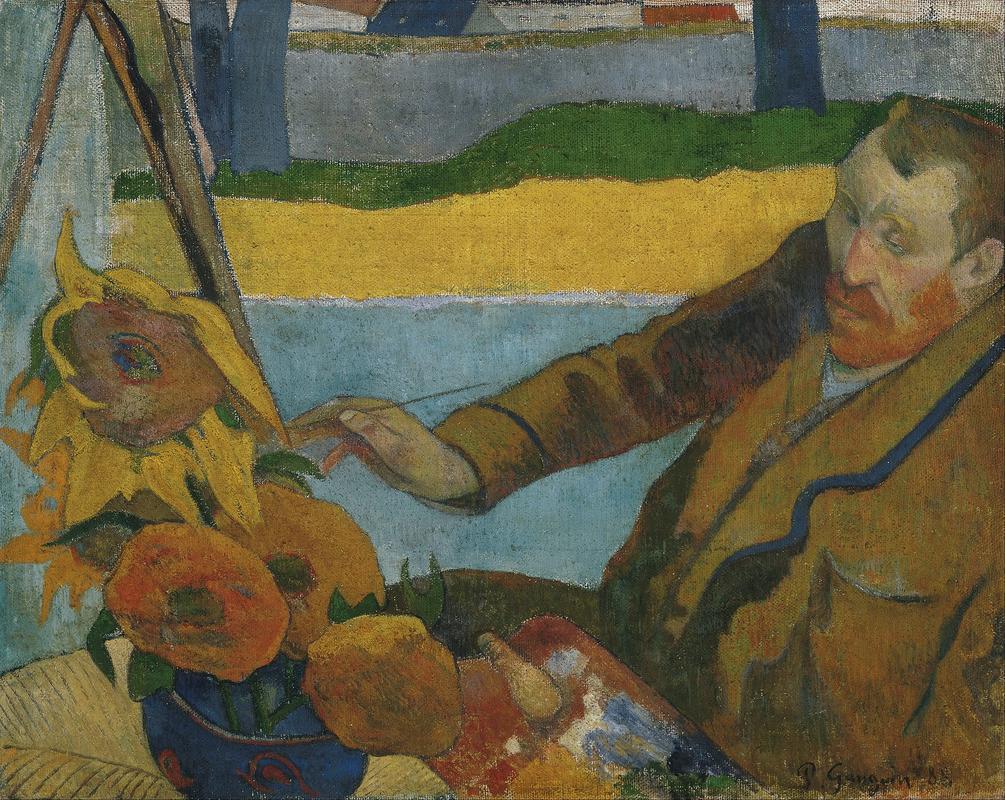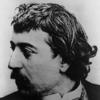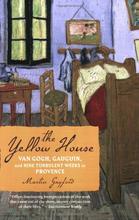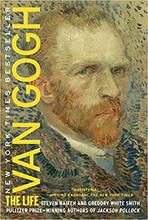More about Vincent van Gogh Painting Sunflowers
- All
- Info
- Shop

Contributor
You might be thinking, “Aww, how sweet of Gauguin to paint his friend Vincent,” but we’d have to stop you right there.
To say Vincent van Gogh and Paul Gauguin disagreed a lot is an understatement. By the end of 1888, when this painting was completed, the Arles roomies were basically at each other’s throats, resulting in the loss of an ear on van Gogh’s behalf. The Painter of Sunflowers isn’t so much a portrait of van Gogh painting his famous Sunflowers as it is a behind-the-scenes look of what really happened in the yellow house.
For starters, this isn’t a good portrait of van Gogh. Gauguin himself admitted to Vincent’s brother Theo that the painting wasn’t a good likeness of Vincent. It’s true, the figure in the painting does have van Gogh’s signature orange beard, but based off what we’ve seen in van Gogh’s self portraits, he shouldn’t have the low forehead, sunken eyes, or flattened nose we see here. Turns out Gauguin accidentally included his own facial features instead of van Gogh’s. We could interpret the subconscious intermingling of van Gogh’s and Gauguin’s characteristics as a result of their stay together, but it’s more likely due to Gauguin being a bit selfish.
The portrait of the now-beloved Impressionist is so inaccurate that it’s disturbing, especially the ape-like facial structure of van Gogh in the painting. Both Gauguin and van Gogh were fascinated by phrenology, the pseudo-scientific belief that cranial shape and size indicated specific personality traits. Gauguin may have been trying to suggest that van Gogh was unintelligent or unevolved. The downward composition of the painting tells us the painter held a literal stance above van Gogh and likely believed he was superior. Gauguin makes van Gogh look as though he’s possessed, possibly hinting at his declining mental health.
At the same time, the portrait could be an homage to van Gogh’s artistic mastery. The positioning of his paintbrush suggests he’s painting the sunflowers rather than the canvas, implying that, for van Gogh, no gap exists between the subject and its representation. Still life versus imagination was one of their heavily debated topics, so this could actually be a jab at van Gogh’s creative process. However, Gauguin adored van Gogh’s Sunflowers series, so while he may have not approved of van Gogh’s methods, he was clearly impressed nonetheless.
Vincent van Gogh wasn’t exactly pleased with the finished product. He responded to the portrait saying, “It’s me, but it’s me gone mad,” but he later came to terms with it. Gauguin gifted the painting to Theo van Gogh as a way to make amends for wanting to leave Arles before schedule. The conflicting elements of admiration and contempt seen in The Painter of Sunflowers not only reflect the growing tension between van Gogh and Gauguin that would lead to their inevitable split, but the conflicting feelings Gauguin felt toward his roommate as well. In van Gogh, Gauguin found his match‒whether he liked it or not.
Sources
- Douglas W. Druick et al., Van Gogh and Gauguin: The Studio of the South (London: Thames and Hudson, 2001).
- Martin Gayford, The Yellow House: van Gogh, Gauguin, and Nine Turbulent Weeks in Arles (New York: Little, Brown and Company, 2006).
- Bradley Collins, Van Gogh and Gauguin: Electric Arguments and Utopian Dreams (Colorado: Westview Press, 2001), 160.
- Mark Roskill, Van Gogh, Gauguin, and the Impressionist Circle (Connecticut: New York Graphic Society Ltd, 1970),
Featured Content
Here is what Wikipedia says about The Painter of Sunflowers
The Painter of Sunflowers (in French: Le Peintre de Tournesols) is a portrait of Vincent van Gogh by Paul Gauguin. Van Gogh is depicted sitting before an easel, presumably painting his “Sunflower” series. The work, which is a piece from Gauguin’s “Arles Period”, was created in Arles, France, in December, 1888. The painting is in the collection of the Van Gogh Museum in Amsterdam.
Check out the full Wikipedia article about The Painter of Sunflowers














